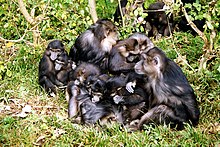article source
Over the past several years, some Balinese have turned their hands to making miniature ogoh-ogoh dolls for local children.
In the shops that line the streets of the village of Sukawati, for example, visitors can find dozens of brightly colored ogoh-ogoh for sale, some crafted from foam and sporting fake fur for their hair and moustaches, while others are dressed in traditional Balinese costume.
At the shop of wayang puppet maker Ketut Kubrata, a young woman is choosing the perfect effigy for her son.
“I think I’ll take the red one. It is my son’s eighth birthday and he will feel really proud to play with the ogoh with his friends,” says 39-year-old Ariani, who has made the drive from Bongkasa for her purchase.
Ketut, 52, says that he has sold more than 400 ogoh dolls in the past two months, and the income has helped his family enormously.
He is helped in the ogoh creation by his wife, Eno, and his 16-year-old daughter, Sri Kumalayanti.
“I’ve been helping Dad make the ogoh for the past two years,” Sri says. “I add the hair and moustaches and dress the dolls. I like this work because it is art. I can learn more about art and sculpture doing this work.” Sri also works alongside her father as a puppet maker.
Miniature: An ogoh doll almost as big as these children will be treasured.
“Normally I work as a barong [dancer] and puppet maker,” says Ketut. “So this ogoh doll making is a side job for a bit of extra income. It helps a great deal, and I am very proud to have my daughter also making the ogoh-ogoh. She is the only girl in Sukawati doing this and working as an artist,” says Ketut as he serves another customer, 40-year-old Bu Agung who is choosing a doll for her little son. The doll almost as large as the boy.
A few kiosks away, 24-year-old Komang Kumanadi is also busy finishing off ogoh dolls to sell on his last day of crafting the effigies before the holiday period for Nyepi begins.
“I make the ogoh to sell to local kids who like to carry them through the streets. Some are burned, but most are kept as toys. I get different design ideas for the dolls from our Hindu stories, such as Hanoman, giants and nasty old women called celuluk. This Nyepi season I will earn after costs about $700, and that is a lot for my family,” says Komang.
He points out that only rarely are the large community ogoh-ogoh ever sold, but the popularity of children’s toy ogoh was growing.
“There are no rules in our religion against making the dolls and it’s a side job that keeps my family going in the quiet times,” says Komang, who like Ketut and many others has found a way to earn an income through Bali’s traditions and religious beliefs, ensuring their survival into the future.





